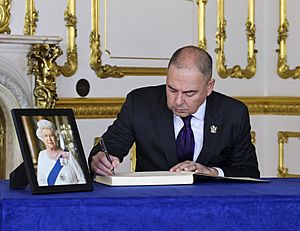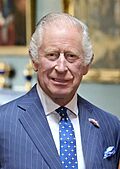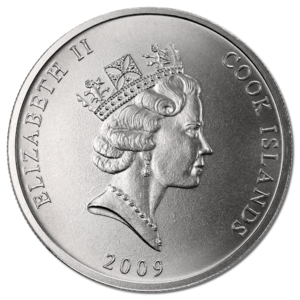Monarchy in the Cook Islands facts for kids
The Cook Islands are a special kind of country called a constitutional monarchy. This means they have a King or Queen as their Head of State, but the government is run by elected officials following a constitution. The Cook Islands are part of the Realm of New Zealand, which is like a family of countries connected to New Zealand. Since August 4, 1965, the King or Queen of New Zealand has also been the Head of State for the Cook Islands. Currently, this is King Charles III. The King has a special person called the King's Representative who acts on his behalf in the Cook Islands. This person helps carry out the King's duties there.
Contents
A Look Back: History of the Monarchy
In 1965, Queen Elizabeth II became the Head of State for the Cook Islands. This happened when the Cook Islands became a "self-governing state in free association" with New Zealand. This meant they could make their own laws but still had a special link to New Zealand and the Queen.
The Cook Islands Constitution, which is like their rulebook, says that "Her Majesty the Queen in Right of New Zealand shall be the Head of State of the Cook Islands." This means the Queen (and now the King) is the Head of State because of her role in the wider Realm of New Zealand. The Realm of New Zealand includes New Zealand itself, the Cook Islands, Niue, Tokelau, and the Ross Dependency.
So, Queen Elizabeth II was the Head of State for the Cook Islands because she was the Head of State for the entire Realm of New Zealand. When Queen Elizabeth II passed away on September 8, 2022, her son, King Charles III, immediately became the new Head of State for the Cook Islands.
The King's Official Title
The King's full official title is: King Charles the Third, By the Grace of God King of New Zealand and of His Other Realms and Territories, Head of the Commonwealth, Defender of the Faith. This long title shows his role in many countries.
Who Comes Next: Royal Succession

The rules for who becomes the next King or Queen are set out in a law called the Royal Succession Act 2013. This law explains that the Monarch cannot be a Roman Catholic. They must also be part of the Church of England when they become King or Queen.
The person next in line to the throne is King Charles III's oldest son, William, Prince of Wales.
The King's Representative
The King's duties in the Cook Islands are mostly carried out by a special person called the King's Representative. For example, when new laws are passed by the Cook Islands Parliament, the King's Representative usually gives them royal approval to make them official.
The King's Representative is chosen directly by the King or Queen. This person must act on the advice of the Cook Islands government ministers. This means they follow the advice of the Prime Minister and the Cabinet of the Cook Islands.
The King's Representative has important powers in the Cook Islands. This means the Governor-General of New Zealand does not have a direct role in the Cook Islands' daily government.
Royal Symbols in the Cook Islands
You can see signs of the monarchy all around the Cook Islands. For example, important legal documents often mention the "Crown." People who take on important jobs, like the King's Representative, Members of Parliament, and judges, promise to be loyal to the King as the Head of State.
Unlike in the United Kingdom, the King's Official Birthday is a public holiday in the Cook Islands. It is celebrated on the first Monday in June. You can still see Queen Elizabeth II's picture on the front of some coins. Her portrait is also used as a watermark on all banknotes until new money with King Charles III's picture is printed. The Cook Islands use the New Zealand dollar for their money.
Queen Elizabeth II visited the Cook Islands on a royal tour from January 28 to January 29, 1974.
Kings and Queens of the Cook Islands
This table shows the monarchs who have reigned over the Cook Islands. It covers the time when it was a British colony, then a New Zealand colony, and finally a self-governing country.
| Portrait | Regnal name (Birth–Death) |
Reign | Full name | Consort | House | |
|---|---|---|---|---|---|---|
| Start | End | |||||
| As a British colony | ||||||
 |
Victoria (1819–1901) |
9 October 1900 | 22 January 1901 | Alexandrina Victoria | Widowed | Hanover |
 |
Edward VII (1841–1910) |
22 January 1901 | 11 June 1901 | Albert Edward | Alexandra of Denmark | Saxe-Coburg and Gotha |
| As a New Zealand colony | ||||||
 |
Edward VII (1841–1910) |
11 June 1901 | 6 May 1910 | Albert Edward | Alexandra of Denmark | Saxe-Coburg and Gotha |
 |
George V (1865–1936) |
6 May 1910 | 20 January 1936 | George Frederick Ernest Albert | Mary of Teck | Windsor |
 |
Edward VIII (1894–1972) |
20 January 1936 | 11 December 1936 | Edward Albert Christian George Andrew Patrick David | None | Windsor |
 |
George VI (1895–1952) |
11 December 1936 | 6 February 1952 | Albert Frederick Arthur George | Elizabeth Bowes-Lyon | Windsor |
 |
Elizabeth II (1926–2022) |
6 February 1952 | 4 August 1965 | Elizabeth Alexandra Mary | Philip Mountbatten | Windsor |
| As a self-governing country | ||||||
 |
Elizabeth II (1926–2022) |
4 August 1965 | 8 September 2022 | Elizabeth Alexandra Mary | Philip Mountbatten | Windsor |
| Queen's Representatives (from 1975): Sir Gaven Donne, Sir Graham Speight (acting), Sir Tangaroa Tangaroa, Sir Apenera Short, Laurence Greig (acting), Sir Frederick Tutu Goodwin, Sir Tom Marsters | ||||||
| Premiers (1965-1981) / Prime Ministers (from 1981): Albert Henry, Sir Thomas Davis, Sir Pupuke Robati, Sir Geoffrey Henry, Joe Williams, Sir Terepai Maoate, Robert Woonton, Jim Marurai, Henry Puna, Mark Brown | ||||||
 |
Charles III (born 1948) |
8 September 2022 | present | Charles Philip Arthur George | Camilla Shand | Windsor |
| King's Representatives: Sir Tom Marsters | ||||||
| Prime ministers: Mark Brown | ||||||
Timeline of Kings and Queens

See also



